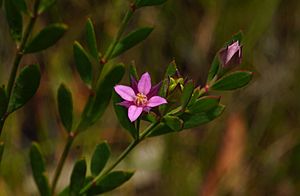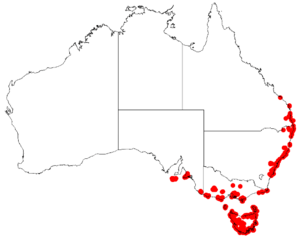Swamp boronia facts for kids
Quick facts for kids Swamp boronia |
|
|---|---|
 |
|
| Boronia parviflora near Shoal Bay | |
| Scientific classification | |
 |
|
| Occurrence data from Australasian Virtual Herbarium |
The Swamp Boronia (scientific name: Boronia parviflora) is a beautiful small plant found in south-eastern Australia. It belongs to the citrus family called Rutaceae. This plant is special because it is endemic to south-eastern Australia, meaning it naturally grows only in that area.
People also call it the small boronia, tiny boronia, or small-flowered boronia. It's usually a low-growing shrub with smooth stems. Its leaves are shaped like ovals or eggs and have tiny teeth along their edges. The Swamp Boronia often has pretty pink, white, or green flowers, each with four petals.
Contents
What it Looks Like
The Swamp Boronia is a small, low-growing shrub. It usually grows to be about 0.1 to 1 meter (about 4 inches to 3 feet) tall. Its stems are smooth and do not have hairs.
Leaves
The leaves of the Swamp Boronia are simple, meaning they are not divided into smaller leaflets. They attach directly to the stem without a stalk. Each leaf is shaped like an oval or an egg. They are usually between 7 and 26 millimeters (about 0.3 to 1 inch) long and 1.5 to 6.5 millimeters (about 0.06 to 0.25 inches) wide. The edges of the leaves have fine teeth. Sometimes, the leaves can look reddish or purplish, especially on the underside.
Flowers
The flowers grow either by themselves or in small groups of up to three. They appear where the leaves meet the stem or at the very ends of the branches. Each flower sits on a small stalk called a pedicel, which is about 2 to 11 millimeters long.
The flower has four parts called sepals, which are like small, leaf-like structures that protect the bud. These sepals are shaped like triangles, are green or red, and are smooth. They are about 2.5 to 6 millimeters long.
There are also four petals, which are the colorful parts of the flower. They can be pale pink, bright pink, white, or sometimes even green. The petals are about the same length as the sepals, and their bases overlap each other.
Inside the flower, there are stamens, which are the parts that produce pollen. These stamens are usually hairy. The stigma, which is the part that receives pollen, is very tiny. Most Swamp Boronia plants in Queensland, New South Wales, and Tasmania have eight stamens. However, in western Victoria and South Australia, some plants might only have four or six stamens.
Flowering and Fruit
Swamp Boronia plants usually flower from August to March. After flowering, the plant produces a fruit called a capsule. This capsule is smooth and about 2 to 4 millimeters long and 1.5 to 2.5 millimeters wide.
How it Got its Name
The scientific name Boronia parviflora was first officially described in 1798 by a scientist named James Edward Smith. He wrote about it in his book Tracts relating to natural history. Smith also gave it the common name "pale-flowered boronia."
The second part of its scientific name, parviflora, comes from two Latin words:
- parvus, which means "small"
- -florus, which means "-flowered"
So, parviflora simply means "small-flowered," which perfectly describes this plant!
Where it Lives
The Swamp Boronia grows in areas that are wet for part of the year. You can find it in places like heathlands, woodlands, and areas with sedges. It is the most widespread type of boronia plant.
You can find it in near-coastal areas, starting from the Sunshine Coast in Queensland. It grows south through New South Wales, reaching as far inland as Boonoo Boonoo. It is also found in Tasmania and in scattered spots in southern Victoria and south-eastern South Australia.
Conservation
In South Australia, the Swamp Boronia is considered "very restricted." This means there are not many of these plants left in that state.
The main things that threaten this plant in South Australia are:
- Grazing: Animals eating the plants.
- Trampling: Animals or people walking on and damaging the plants.
- Competition: Other plants that have been brought into the area (like pasture grasses) growing too close and taking away space and nutrients from the Swamp Boronia.

